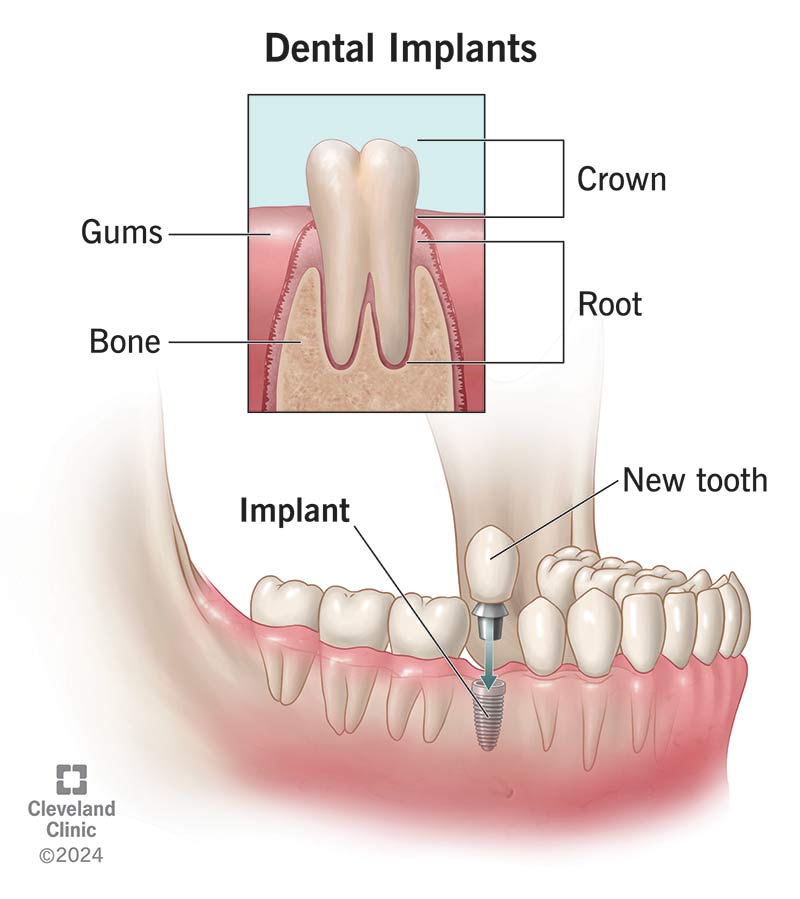Dental Implants Fundamentals Explained
Table of ContentsThe Buzz on Dental ImplantsExamine This Report about Dental ImplantsAbout Dental ImplantsThe Single Strategy To Use For Dental Implants
are clinical gadgets operatively implanted right into the jaw to restore a person's capability to eat or their look. They provide support for artificial (phony) teeth, such as crowns, bridges, or dentures. When a tooth is shed as a result of injury or condition, an individual can experience complications such as fast bone loss, faulty speech, or modifications to eating patterns that cause pain.
Structure of The Oral Implant System choosing dental implants, speak to your dental service provider about the potential advantages and risks, and whether you are a prospect for the procedure. Things to take into consideration: Your total wellness is a crucial element in figuring out whether you are an excellent prospect for oral implants, how much time it will certainly take to recover, and the length of time the implant may remain in area.
Cigarette smoking may influence the healing procedure and reduce the long-term success of the dental implant. The recovery procedure for the implant body may take several months or longer, throughout which time you generally have a short-term abutment in location of the tooth. the oral implant treatment: Carefully follow the oral health directions provided to you by your oral service provider.
See This Report on Dental Implants
Implant failure can cause the demand for one more medical procedure to take care of or replace the implant system. Restores the ability to chew Brings back cosmetic look Assists maintain the jawbone from shrinking as a result of bone loss Maintains the health of the bordering bone and gums Assists keep surrounding (close-by) teeth secure Improves quality of life Damages to bordering natural teeth during implant positioning Injury to the surrounding tissues throughout surgical treatment, such as sinus opening Injury throughout surgery (for example, crack of bordering jawbone) Poor function, such as seeming like the teeth do not bite together normally An experience that the tooth hangs or turning in area resulting from a joint screw loosening Implant body failing (looseness of the implant body) because of systemic infection, which might be more probable in clients with unchecked diabetics issues because of local infection in bone and periodontals supporting the implant body as a result of postponed healing, which might be more probable in people that smoke Trouble cleaning up the periodontals around the implant, leading to bad dental hygiene Without treatment gum illness Post-surgical pins and needles because of nerve impingement or damage Constantly alert health and wellness treatment providers and imaging specialists that you have oral implants before any type of magnetic vibration imaging (MRI) or x-ray treatments.
FDA is not familiar with any damaging events reported for MRI or x-ray procedures with dental implants. Dental implants systems are generally constructed from materials that comply with global agreement requirements of the International Organization for Standardization (ISO) or ASTM International. These requirements have information of what This Site makes a secure material.
Other materials such as gold alloys, cobalt-based alloys, titanium alloys, or ceramic products are sometimes made use of. The safety and security profiles of these products are popular. Dental dental implant systems are examined according to international agreement requirements. Biocompatibility testing, to reveal that bodily contact with the device does not cause issues like irritability or allergic reaction, is part of the analysis that helps guarantee the materials in the oral implant system are safe and do not trigger negative effects when dental implanted in individuals.

The smart Trick of Dental Implants That Nobody is Discussing
Some people are not qualified for dental implant surgery. It is for dental surgeons to operate on individuals with: acute illnessuncontrollable metabolic diseasebone or soft cells condition or infectionIf these concerns are solved, a person can have the surgical treatment. Dental Implants. In, oral doctors refrain from running on individuals with: If people with any one of the above undertake dental implant surgical treatment, there is a greater risk of the implant falling short
Some individuals have a jawbone abnormality that stops enough bone for a dental implant from establishing. In such cases, a doctor might need to execute a ridge alteration. This includes lifting the gum tissue to expose the area of warped bone. The cosmetic surgeon will then use a bone or bone replacement to fix and accumulate the area.
Dental dental implant surgery is an individualized process. look at here now It's not the very same for everybody. However the adhering to gives a basic review of what you can anticipate your dentist, oral cosmetic surgeon, periodontist or prosthodontist to do: Place the implant operatively. Provide you time to heal. Connect the blog post and final crown, bridge or denture.
Next off, your surgeon will very carefully put the oral implant right into your jaw. Your cosmetic surgeon will reposition your gums and shut the incision with stitches (Dental Implants). If your dental implant is near the front of your mouth, your dental expert will certainly make a temporary tooth for you to wear until you heal. By doing this, you from this source won't have a space in your smile while you recover.
The Ultimate Guide To Dental Implants
Throughout the healing phase, your jawbone should fuse to the oral implant. This procedure can take anywhere from three to 9 months.
Once your implant heals, your dental professional can attach the abutment (little connector blog post) and your final restoration (crown, bridge or denture). This usually takes about one hour to complete and might need a second small surgical treatment. You shouldn't really feel any kind of discomfort throughout your oral implant procedure because your provider will certainly use medicine to numb your periodontals.